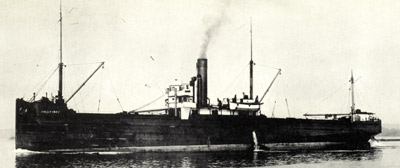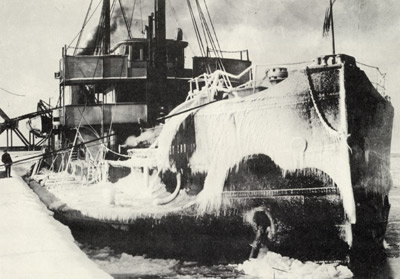Table of Contents
In 1891 a new type of ocean-going cargo carrier of radical design was patented by William Doxford & Sons Ltd. of Sunderland, England. It was known as the "turret" design and the prime reason for this type of vessel was to effect a saving in canal and harbour dues. This result was achieved by reducing both the net tonnage and the area of exposed upper deck to a minimum and, in addition, the cargo area was increased.
From the turn of the bilge to a few feet above the load line, a turret steamer did not differ from the conventional hull form of cargo vessels but, above this point, the side shell plating curved inward to create a narrow deck space called the "harbour deck", which was, of course, just a part of the shell plating. From the inner side of the harbour deck, the plating curved to rise perpendicularly to meet the narrow flush upper deck on which were erected the bridge structure and the usual deck fittings including winches, derrick posts, hatches, etc. The crew's quarters were extremely cramped as a result of the narrow deck and scarcely provided room for turning around. As one who sailed in these ships during their lake service has put it so aptly, "if you walked into a cabin, you had to back out."

JOLLY INEZ, formerly TURRET CHIEF, passes up Little Rapids Cut at Sault Ste. Marie in 1923. Young photo. Bascom collection.
The Doxford design did not meet with the approval of Lloyds' Classification Committee when the plans were first submitted. In order to demonstrate the seaworthiness and cargo carrying advantages of the new type, Doxfords, in association with the prominent ship owner Capt. William Peterson, built the first turret vessel, sharing the costs and risks involved equally. This steamer was appropriately named TURRET. The new ship's behaviour in heavy seas and her manoeuvrability on her first voyage won the approval of Lloyds' Committee. The turret design proved profitable and gained much favour with owners trading to the Far East through the Suez Canal where tolls were levied on the basis of deck area.
During the 1890's and early 1900's, more than 150 Turrets were built by Doxford and some of them were quite large. However, the popularity of the class began to wane after the turn of the century as large vessels were required and the advantage of lower canal and harbour dues was lost due to a change in the way these fees were calculated. The Turrets were rather difficult to unload as the narrow deck limited the width of hatches. Like their cousins, the Whalebacks, the turret ships had their day and lost their popularity when progress and the need for larger ships rendered them obsolete

After doing battle with Lake Superior, TURRET CROWN waits for passage down the Sault Canal. Young photo. Bascom collection.
Some of the smaller Turrets found their way into Great Lakes trade during the first years of the century. When William Peterson Ltd. secured a contract in 1900 to haul coal from Sydney, Nova Scotia, to Montreal for Dominion Iron & Steel Co. Ltd., they allocated at least seven of the type, namely, SCOTTISH HERO, TURRET BAY, TURRET BELL, TURRET CAPE, TURRET CHIEF, TURRET CROWN and TURRET COURT, to the trade. The canal-sized units of the group may have ventured into the lakes during this period. TURRET BAY was lost in the Sydney-Montreal service when she stranded near St. Paul's Island in the Gulf of St. Lawrence on May 20, 1904 and foundered with the loss of thirteen lives. She was slightly larger than canal size, being 297 feet in length.
The remaining six Turrets were sold in 1907 to the Canadian Lake and Ocean Navigation Co. Ltd., Toronto, for the lake trade. This concern was managed by R. O. & A. B. MacKay of Hamilton. The principals of Canadian Lake & Ocean were closely allied with the MacKenzie & Mann interests, the Canadian Northern Railroad group. The company became known in 1910 as the Canadian Lake Line and in 1911 became the Canadian Interlake Line, managed by Capt. J. W. Norcross & Associates. In 1913 the line was absorbed into Canada Steamship Lines Ltd., Montreal. In our listing, we have referred to these various groups as Canadian Lake and Ocean for the entire 1907 to 1913 period.
CAPE, CHIEF, CROWN and COURT, being canal size, had no difficulty in transiting the St. Lawrence and Welland canals. However, SCOTTISH HERO and TURRET BELL were larger (297 feet). The HERO was cut at Levis for the canal passage and was rejoined on the Upper Lakes. It was intended to treat the BELL in a like manner, but this did not take place as she stranded in the St. Lawrence and was declared a constructive total loss. Nevertheless, the versatile Capt. Tom Reid of Sarnia and Port Huron eventually salvaged her and sent her back to salt water service as KWASIND.
During World War I, the Turrets left the lakes, being requisitioned for salt water service, The four canallers did return in the 1920's, but they were really only a shadow of their former selves. Their boilers and engines were nearing the end of serviceability (two ships actually had their machinery condemned) and the shell and deck plating was in poor shape. TURRET CAPE lasted the longest, due entirely to the need for tonnage in the second war, she received an extensive rebuild and was dieselized. She finally ended her days at Port Dalhousie in 1959.
Despite their varying sizes, the Turrets that appeared on the lakes were of two basic varieties. SCOTTISH HERO, TURRET BELL, CHIEF and COURT had their machinery and bridges amidships. CROWN and CAPE had the bridge structure amidships but the machinery was aft. This latter pair was also distinguished by their turtle-backed forecastles.
SCOTTISH HERO, 105718. 1895 Wm. Doxford & Sons Ltd., Sunderland. 297.0 x 40.0 x 21.7. Gross 2202, Net 1375. Cut in two sections at Levis 1907 and brought to lakes. Requisitioned for war service on salt water 1916. Cut in two at Ashtabula and taken down canals 1917. Torpedoed and sunk 1917. Owners; l) Scottish Hero Steamship Co. Ltd. (Wm. Peterson Ltd.), Newcastle (1895-1907). 2) Canadian Lake & Ocean Nav. Co. Ltd. (1907-13). 3) Canada Steamship Lines Ltd. (1913-17). 4) Hero Steamship Co., Halifax (1917).
TURRET BELL (12), (b) KWASIND. 104263. 1894 Wm. Doxford & Sons Ltd., Sunderland. 297.0 x 40.0 x 21.7. Gross 2211, Net 1376. Wrecked on St. Lawrence 1907 and abandoned. Later salvaged. Taken back to salt water 1912. Mined on March 11, 1917 near Southend, England. Owners: l) Turret Steam Shipping Co. (Wm. Peterson Ltd. - Peterson, Tate & Co.) (1894-1907). 2) Canadian Lake & Ocean Nav. Co. Ltd. (1907). 3) Reid Wrecking Co., Sarnia (1907-12). 4) Arctic Steamship Co. Ltd., Quebec (1912-17).
TURRET CAPE (41) (b) SUN CHIEF (49), (c) WALTER INKSTER. 104283. 1895 Wm. Doxford & Sons Ltd., Sunderland, Hull 234 253.0 x 44.0 x 19.4. Gross 1827 Net 1142. Brought to lakes 1907. Requisitioned for war service on salt water 1915. Operated during 1920's in lake and river trade. Engines condemned 1930. Lay idle until converted 1937 to a barge for flour storage. Rebuilt 1941 at Montreal as a diesel stemwinder for bauxite trade between British Guiana and Port Alfred, P. Q. Gross 2079, Net 1158. Converted 1943 to a suction dredge for the Demerara River but soon reverted to Demerara-Trinidad bulk trade. Returned to lakes 1949. After several years of inactivity at Lakehead, sold 1956 for scrap and moved to Port Dalhousie under own power. Scrapped at Port Dalhousie 1959. Owners: l) Wm. Peterson Ltd. (1895-1907). 2) Canadian Lake & Ocean Nav. Co. Ltd. (1907-13). 3) Canada Steamship Lines Ltd. (1913-16). 4) Turret Steamship Co. Ltd. (Dominion Iron & Steel Co. Ltd.) Halifax, (1916-17). 5) Cape Steamship Co. Ltd (Dominion Iron & Steel), Halifax (1917-25). 6) International Waterways Nav. Co. Ltd. (R. W. Campbell & J.E. Russell), Montreal (1925-37). 7) Fort William-Montreal Nav. Co. Ltd. (Robin Hood Flour Mills Ltd.). (1937-41). 8) Saguenay Terminals Ltd., Montreal (1941-49). 10) Colonial Steamships Ltd. (1951-56). 11) A. Newman & Co., St. Catharines (1956-59).
TURRET CHIEF (15), (b) VICKERSTOWN, (c) JOLLY INEZ (27), (d) SALVOR. Br. 106605, U.S. 170538. 1896 Wm. Doxford & Sons Ltd., Sunderland. 253.0 x 44.0 x 19.7. Gross 1850, Net 1150. Brought to lakes 1907. Stranded 6 miles east of Copper Harbor, Keewenaw Peninsula, Lake Superior, November 8, 1913. Abandoned to insurers. Salvaged 1914, and rebuilt at Port Arthur. Requisitioned for war service 1914 and served as a munitions carrier between Britain and Archangel. Returned to lakes 1922. Stranded under peculiar circumstances on Saddlebag Island, False DeTour Channel, Lake Huron, November 16, 1927. Abandoned. Salvaged by T. L. Durocher and converted to a lightering barge. Gross 1731, Net 1688. Broke tow and foundered in Lake Michigan off Muskegon, September 26, 1930. 11 lives lost. Owners; l) Wm. Peterson Ltd. (1896-1907). 2) Canadian Lake & Ocean Nav. Co. Ltd. (1907-13). 3) Canada Steamship Lines Ltd. (1913). 4) Entente Steamship Co. (Leopold Walford Ltd.), London (1914-22). 5) International Waterways Nav. Co. Ltd. (1922-27). 6) T.L. Durocher Co., DeTour, Michigan (1927-30).
TURRET COURT, 106608. 1896 Wm. Doxford & Sons Ltd., Sunderland. 253.0 x 44.0 x 19.7. Gross 1879, Net 1197. Brought to lakes 1907. Requisitioned for war service on salt water 1915. Operated in 1920's in lake and river trade. Machinery condemned 1930 and converted to a salvage barge. Latterly inactive at Sorel for a long period. Scrapped at Hamilton 1940. Owners: l) Wm. Peterson Ltd. (1896-1907). 2) Canadian Lake & Ocean Nav. Co. Ltd. (1907-13). 3) Canada Steamship Lines Ltd. (1913-16). 4) Turret Steamship Co. Ltd. (Dominion Iron & Steel Co. Ltd.), Halifax, (1916-25). 5) International Waterways Nav. Co. Ltd. (1925-30). 6) Sincennes - MacNaughton Lines Ltd.. Montreal (1930-40). 7) Steel Company of Canada Ltd. (1940).
TURRET CROWN, 104279. 1895 Wm. Doxford & Sons Ltd., Sunderland. 253.0 x 44.0 x 19.4. Gross 1827, Net 1142. Brought to lakes 1907. Requisitioned for war service on salt water 1915. Operated late in war on Pacific although owned in Toronto. Returned to lakes 1922. Grounded on Cove Island, October 9, 1922. Salvaged. Stranded on Meldrum Point, Manitoulin Island, November 2, 1924. Abandoned as total loss. Hull removed for scrap during World War II. Owners! l) Wm. Peterson Ltd. (1895-1907). 2) Canadian Lake & Ocean Nav. Co. Ltd. (19(37-13). 3) Canada Steamship Lines Ltd. (1913-15). 4) Turret Crown Ltd. (H. W. Harding), (1915-16). 5) Coastwise Steamship & Barge Co., Vancouver, (1916-18). 6) Commonwealth Steamship Co. Ltd., Toronto (1918-21). 7) W. J. & S. P. Herivel. London (1921-22). 8) A. B. MacKay, Hamilton (1922-24). 9) Capt. William C. Jordan, Goderich (1924).
Previous
Return to Home Port or Toronto Marine Historical Society's Scanner
Reproduced for the Web with the permission of the Toronto Marine Historical Society.